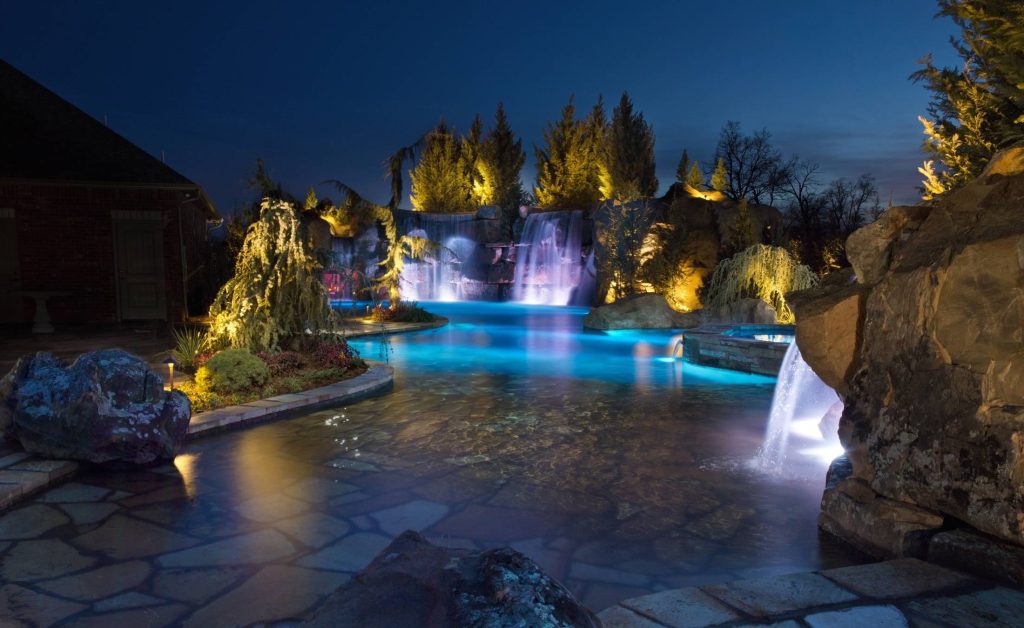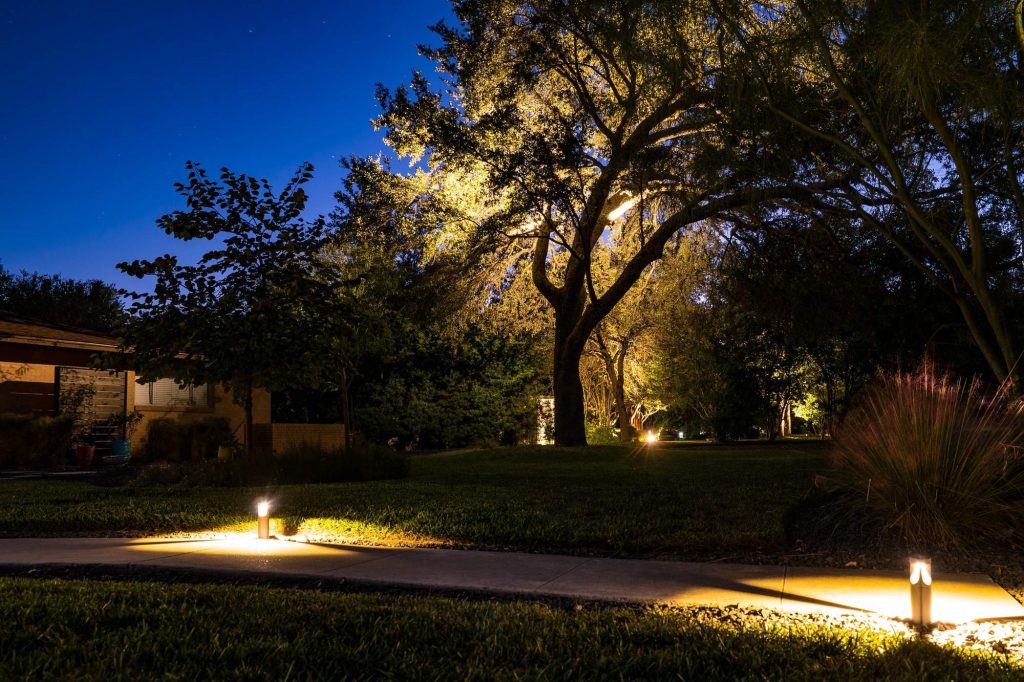The Luminous Allure of Landscape Lighting
The Quintessence and Benefits of Landscape Lighting
Structured, harmonious lighting is an integral part of any outdoor aesthetic. Its significance in landscaping extends far beyond the primary objective of visibility. Elegantly positioned landscape lighting can infuse ordinary exteriors with an ethereal charm, transforming them into inviting, enchanting spaces.
When used judiciously, landscape lighting offers multifaceted benefits that enhance the visual appeal and functionality of your outdoor spaces. It serves as a beacon, guiding visitors along pathways while offering warmth to gardens during twilight hours. It accentuates architectural elements, exposing remarkable textures and shapes unnoticeable during daylight.
The benefits are not solely aesthetic; safety and security are also principal considerations. By illuminating dark corners and obscured areas, landscape lighting deters unwanted intruders while minimizing the risk of mishaps like stumbling or tripping over unseen obstacles in reduced light conditions.
Moreover, strategic placement of lights enhances the perception of space in your garden or patio area. It can create illusions through shadows and highlights, which add depth to flat expanses or downplay less appealing areas. A well-lit exterior enhances property value by adding a sophisticated touch to your home’s overall presentation.
Advancements in technology have made modern lights more energy-efficient than ever before: LED lights last longer than traditional bulbs and consume considerably less power. This means that enhancing your property’s beauty need not come at an exorbitant cost, nor does it require sacrificing sustainability.
Emphasis on Purposeful Lighting
This comprehensive guide is designed for those who wish to venture into the mesmerizing world of landscape lighting but need direction on how best to harness its potential. With myriad possibilities at one’s disposal – from simple solar path lights to dramatic uplighting techniques – understanding how to properly implement these options can be daunting, to say the least.
Our aim is to aid you in navigating these bright waters. We will provide an in-depth understanding of landscape lighting, cover crucial aspects of planning and design, and delve into the selection process for suitable light fixtures. Further sections will explore effective placement techniques and essential installation tips.

This guide serves not just as a starting point for beginners but also as a reference resource for more experienced individuals looking to upgrade or redesign their current lighting arrangements. Through its comprehensive approach, it aims to inform, inspire, and illuminate paths towards creating captivating outdoor spaces that can be cherished at all hours.
With a discerning eye, careful planning, and the knowledge that this guide imparts, you will be able to create an outdoor ambiance that transcends ordinary landscapes into realms of visual poetry – infusing life into every nook and cranny even under the veil of darkness. Grounded in practical information yet touching upon the sublime implications of light on texture and space – this guide is your beacon towards mastering landscape lighting.
Understanding Landscape Lighting: Enhancing Your Outdoor Space
Defining and Describing Landscape Lighting
Landscape lighting can be defined as the strategic arrangement and installation of artificial light sources in an outdoor environment. The objective is to enhance the aesthetic allure, increase functionality during the night, and promote safety and security.
This type of lighting goes beyond simple illumination; it’s a form of art that requires creativity, precision, and understanding of light, shadow, and darkness. This sophisticated form of light deployment demands meticulous planning to achieve harmony between natural features existing in a landscape with artificial lights.
It enables homeowners to display their outdoor properties in the most flattering manner during nocturnal hours. Furthermore, it helps accentuate specific elements like trees or sculptures while providing necessary lighting for pathways or entrances.
Landscape lighting encompasses more than just mounting lights on walls or posts; it involves considering numerous factors such as positioning, intensity of light, color temperature, and types of lights suitable for specific locations. It is an investment that, if done correctly, can drastically increase property value by transforming mundane outdoor spaces into enchanting landscapes.
The key aspect lies in identifying how one wants their landscape to be perceived at nightfall. Do you want your garden to mimic a fairytale setting with a soft glow? Or perhaps you want your architectural features amplified after sunset? These are some questions that need contemplation before venturing into landscape lighting design.
A well-executed landscape lighting invokes feelings of tranquility and elegance while enriching the overall ambiance. It’s about creating an after-dark personality for your home exterior that harmoniously blends functionality with aesthetics.
Diverse Types of Landscape Lights: A Guide to Enhance Your Garden
An array of different types of lights exists within the landscape lighting arsenal, each designed for specific purposes, allowing homeowners to create desired effects in their gardens. Path lights, as the name suggests, are used to illuminate pathways, driveways, or any walkable areas, providing safe navigation during nights. These lights are usually installed at ground level and emit soft light spreading across the path.
Spotlights, on the other hand, are designed to focus intense light on a specific object or area, such as a statue, architectural feature, or tree. They are instrumental in creating centerpieces that grab the immediate attention of viewers or highlight hard-to-see areas, enhancing every minute detail.

Floodlights serve a different function by casting wide and bright beams of light over large expanses like driveways, walls, trees, or open lawns. They provide an ideal solution for ensuring outdoor security and discouraging unwanted visitors while covering large areas that other types can’t cater to.
Lesser-known types like well-lights and hardscape lights offer unique solutions for specific situations. Well-lights virtually invisible during the daytime are buried in ground used for uplighting trees or structures. Hardscape lights on contrast neatly fit within stone walls, providing a soft glow across the surfaces.
The selection process involves scouting through these different types, each providing unique lighting solutions for your outdoor spaces while considering their design compatibility with your landscape aesthetics.
Significance of Lighting in Landscaping: Safety and Beyond
Landscape lighting plays an integral role in promoting safety by illuminating dark corners, which can be potential tripping hazards, especially along pathways and stepways. It deters intruders from trespassing onto your property, thus improving security and thereby instilling a sense of assurance among homeowners when they retire for the night.
Apart from its pragmatic uses, it offers numerous aesthetic benefits as well by accentuating architectural features that would otherwise go unnoticed after sunset, such as sculptures or fountains, thereby increasing the visual appeal of your abode. It helps in creating an inviting and comfortable atmosphere for socializing during nighttime outdoor gatherings.
Moreover, it contributes to curb appeal by enhancing the property’s nighttime visual appeal. A well-lit landscape creates a lasting impression on passersby and visitors alike while increasing the perceived value of your property, which can have significant positive impacts during property sales.
Landscape lighting also aids in harmonizing natural features like trees or shrubs with built structures like pergolas or decks, creating a cohesive visual treat that is eye-pleasing. It draws attention to carefully curated garden elements showcasing homeowners’ tastes and preferences.
In essence, landscape lighting is not just an accessory but a necessity that adds value, safety, aesthetics, and functionality to any home landscape, making it an essential element of modern landscaping endeavors.
The Lighting Art: Planning Your Landscape Lighting
An integral part of designing your landscape lighting scheme is the initial planning stage. This requires evaluating your outdoor space with a discerning eye.
Walk around your property during different times of the day to observe how light falls naturally. This will give you the opportunity to identify key features that could be accentuated with strategic lighting, such as mature trees, architectural elements, or a water feature.
Consider the natural sources of light and shadows cast in your area. The sun’s position changes throughout the year, which can dramatically affect how shadows are cast on different portions of your yard. By observing these patterns, you can design a lighting scheme that complements natural sunlight and minimizes harsh shadows.

Likewise, take note of any potential obstacles for installation, like large rocks, roots, or utility lines. Understanding these limitations ahead of time will save you from unnecessary complications during the installation process.
Next comes defining your lighting goals – are you aiming to create a romantic or dramatic mood by spotlighting certain features? Or perhaps it’s all about enhancing security around dark corners or walkways? Once defined, sketch out a rough blueprint of your yard, including proposed placements for each light fixture.
Choosing Your Lights: The Beacon Selection
Navigating through endless types and styles of lights may seem daunting; however, understanding their basic differences helps refine choices. Two common types are LEDs (light-emitting diodes) and halogens. LED lights are energy-efficient and long-lasting but often more expensive initially; halogen lamps provide warmer tones but consume more energy and need frequent replacement.
Selecting appropriate fixtures entails aligning both function and style – the design should harmonize with your home’s architecture while serving its purpose effectively. For instance, path lights should be durable enough to withstand high traffic areas yet aesthetically pleasing along garden pathways.
Moreover, keep energy efficiency in mind as well. Opting for solar-powered or low-voltage lights can significantly reduce energy consumption and maintenance costs in the long run.
Placement Techniques for Landscape Lighting: The Symphony of Lights and Shadows
The essence of effective landscape lighting lies in strategic placement. One general rule is to avoid light pollution – unnecessary or excessive outdoor lighting that can disrupt ecosystems and human sleep cycles. This can be done by properly angling your lights downward and using fixtures with shields to prevent light from spilling into the sky.

Another technique is moonlighting, where lights are placed high up in trees or other structures, casting downward light that mimics natural moonlight. It’s a subtle yet impactful way to create enchantment in your landscape. Specific strategies also apply based on the type of fixtures used.
Pathway lights should be evenly spaced along walkways for consistent lighting, while spotlights are more focused beams directed at specific features like statues or unique plants. Floodlights, on the other hand, cover a broader area and should be used sparingly to avoid overwhelming brightness.
Installation Tips & Safety Measures: Setting a Safe Stage
Choosing between DIY (do-it-yourself) installation and hiring professionals is largely dependent on your budget, time availability, skill level, and complexity of the project. Professionals may ensure proper installation but come at a higher cost; conversely, DIY can save money but requires more time investment.
Regardless of who installs your landscape lighting system, safety should always be paramount. Only use outdoor-rated fixtures and cables to withstand weather elements. Avoid overloading circuits by following manufacturer load limits, and always turn off electricity when working with wires.
Conclusion: How to Properly Place Landscape Lighting?
Landscape lighting is both an art form and a practical investment in safety – a delicate dance between shadowy mystery and enlightening clarity that enhances the beauty of your home’s exterior while simultaneously providing functionality through increased visibility and security. With careful planning, the right choice of lights, strategic placement, and safe installation techniques, you could transform your landscape into a magical nightscape that leaves an indelible impression on anyone who beholds it. As you embark on this journey of light-induced transformation, remember that, like in life itself, even in landscaping, the darkest corner has the potential to brighten up with just the right amount of light.
You may also be interested in the following posts:
